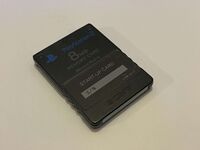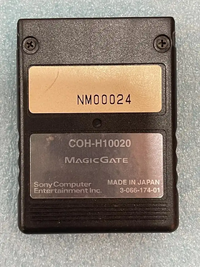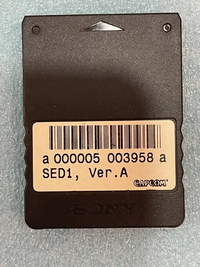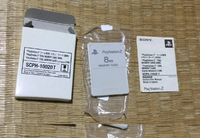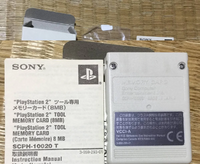Memory Card: Difference between revisions
m (→Hardware) |
(grammar) |
||
| (6 intermediate revisions by 5 users not shown) | |||
| Line 1: | Line 1: | ||
= Overview = | = Overview = | ||
The main console storage device for user data. It is used to store game saves, DVD Player updates, gameplay history records and more on the system. | |||
Normal memory cards from Sony, labeled as SCPH-10020, come in different colors and store 8MB. Officially licensed memory cards from Katana can store up to 16MB and 32MB; these memory cards store up to 8MB on each page. Unlicensed cards with different capacities also exist. | |||
Official cards are capable of using both the developer and retail MagicGate keys. By default they use the developer keys, until they receive the '''0xF7''' card command, which issues a card key change on the card controller. | |||
The SECRMAN driver from DTL-H models does not issue this command, allowing retail cards to work on them. Arcade and developer cards are coded to completely ignore the 0xF7 command. | |||
= Hardware = | = Hardware = | ||
There are several variants of memory card | There are several variants of memory card, at least functionality wise. | ||
=== TDB | === TDB Start-Up Card === | ||
[[File:PS2-TDB START-UP CARD.jpg|200px|]] | [[File:PS2-TDB START-UP CARD.jpg|200px|]] | ||
A special memory card reserved exclusively for executing some basic debugger on DTL-H models. more information can be found on | A special memory card reserved exclusively for executing some basic debugger on DTL-H models. more information can be found on its own dedicated article: [[TDB Start-up Card]] | ||
It uses the developer MagicGate keys. | It uses the developer MagicGate keys. which makes its contents inaccessible from non-developer hardware. | ||
=== Arcade Memory Card COH-H10020 === | === Arcade Memory Card COH-H10020 === | ||
| Line 14: | Line 22: | ||
[[File:COH-H10020 back.png|200px|]] [[File:COH-H10020 front.png|200px|]] | [[File:COH-H10020 back.png|200px|]] [[File:COH-H10020 front.png|200px|]] | ||
Used by Namco System 246/256 as security dongles. these cards served as Storage for arcade games executables, as well as IRX drivers, IOPRP images and similar files. | Used by Namco System 246/256 as security dongles. these cards served as Storage for arcade games executables, as well as IRX drivers, IOPRP images and similar files. These are plugged to slot 1 exclusively. | ||
These cards are also needed to keep those systems working. (system shutdowns if dongle is not | These cards are also needed to keep those systems working. (system shutdowns if dongle is not authenticated in a span of 5 mins) | ||
=== Soul Calibur 2 Campaign Card === | === Soul Calibur 2 Campaign Card === | ||
[[File:SoulCalibur2 Arcade conquest card.png]] | [[File:SoulCalibur2 Arcade conquest card.png]] | ||
A normal memory card that seems to use a custom memory card filesystem paired with special encryption | Also known as Conquest Card. | ||
A normal memory card that seems to use a custom memory card filesystem (or no FS at all?) paired with special encryption to store progress of the SoulCalibur2 "Conquest Mode". it is still unknown how to bypass this. | |||
Seems like these cards were made using the recalled memory cards from the Japanese release of the PlayStation 2, the ones with the CXD9585AR/CXD9585R (and older) controller chips. | |||
* It uses a different ECC data format than normal cards | * It uses a different ECC data format than normal cards. | ||
* Sectors are encrypted using the per card seed/key from | * Sectors are encrypted using the per card seed/key from its security dongle. | ||
* It uses the retail | * It uses the retail MagicGate keystore because the Namco system 246/256 only auths retail cards on slot 2. | ||
The units destined to | The units destined to America had an additional sticker warning about card corruption/data loss if plugged to a retail PS2. | ||
=== Development TOOL Memory Card === | === Development TOOL Memory Card === | ||
| Line 34: | Line 46: | ||
It is unknown if it had any special purpose/functionality. | It is unknown if it had any special purpose/functionality. | ||
It most likely uses the developer | It most likely uses the developer MagicGate keystore to avoid filesystem access on non developer hardware. | ||
= File System = | = File System = | ||
| Line 143: | Line 155: | ||
|} | |} | ||
A standard | A standard PS2 Memory Card is composed by 1024 blocks, each block contains 16 pages of 528 bytes, for a total of 528*16*1024=8.650.752 bytes (0x840000) | ||
Total ECC data is 16*16*1024=262.144 bytes | Total ECC data is 16*16*1024=262.144 bytes | ||
| Line 152: | Line 164: | ||
Two complete blocks are reserved to deal with the possibility of the memory card being removed by the user when data is being saved. Writing data to card requires erasing and reprogramming an entire block | Two complete blocks are reserved to deal with the possibility of the memory card being removed by the user when data is being saved. Writing data to card requires erasing and reprogramming an entire block | ||
Before writing a block, both '''bblock1''' and '''bblock2''' are erased. Then a copy of the new data that is going to be written is stored in '''bblock1''', and the number of the block that is going to be written is stored in '''bblock2'''. The block being programmed is then erased and | Before writing a block, both '''bblock1''' and '''bblock2''' are erased. Then a copy of the new data that is going to be written is stored in '''bblock1''', and the number of the block that is going to be written is stored in '''bblock2'''. The block being programmed is then erased and re-written. Finally, '''bblock2 is erased'''. | ||
Recovery caused by removal of the memory card is implemented whenever a memory card is inserted into the PS2 by checking '''bblock2''', if it's not erased, then programming is assumed to have not been completed. The contents of '''bblock1''' are then copied to the block given in '''bblock2'''. Then '''bblock2''' is erased | Recovery caused by removal of the memory card is implemented whenever a memory card is inserted into the PS2 by checking '''bblock2''', if it's not erased, then programming is assumed to have not been completed. The contents of '''bblock1''' are then copied to the block given in '''bblock2'''. Then '''bblock2''' is erased. | ||
*Error Correction Code (ECC) | *Error Correction Code (ECC) | ||
The data area of each page (512 bytes) is divided into 128 byte long chunks and for each chunk a simple [[http://en.wikipedia.org/wiki/Hamming_code 20-bit Hamming code]] is calculated and stored in three bytes | The data area of each page (512 bytes) is divided into 128 byte long chunks and for each chunk a simple [[http://en.wikipedia.org/wiki/Hamming_code 20-bit Hamming code]] is calculated and stored in three bytes | ||
The first byte contains the column (or bit-wise) parity bits, with the even groups in the lower nibble and the odd groups in the upper nibble. The second and third bytes contain the even and odd groups respectively for the line (or byte-wise) parity bits | The first byte contains the column (or bit-wise) parity bits, with the even groups in the lower nibble and the odd groups in the upper nibble. The second and third bytes contain the even and odd groups respectively for the line (or byte-wise) parity bits. | ||
The 3 ECC bytes for each of the 4 chunks are stored in order in the page's spare area for a total of 12 bytes | The 3 ECC bytes for each of the 4 chunks are stored in order in the page's spare area for a total of 12 bytes. | ||
Source: | Source: [http://www.csclub.uwaterloo.ca:11068/mymc/ps2mcfs.html PlayStation 2 Memory Card File System - By Ross Ridge] | ||
Latest revision as of 04:38, 1 April 2025
Overview[edit | edit source]
The main console storage device for user data. It is used to store game saves, DVD Player updates, gameplay history records and more on the system.
Normal memory cards from Sony, labeled as SCPH-10020, come in different colors and store 8MB. Officially licensed memory cards from Katana can store up to 16MB and 32MB; these memory cards store up to 8MB on each page. Unlicensed cards with different capacities also exist.
Official cards are capable of using both the developer and retail MagicGate keys. By default they use the developer keys, until they receive the 0xF7 card command, which issues a card key change on the card controller.
The SECRMAN driver from DTL-H models does not issue this command, allowing retail cards to work on them. Arcade and developer cards are coded to completely ignore the 0xF7 command.
Hardware[edit | edit source]
There are several variants of memory card, at least functionality wise.
TDB Start-Up Card[edit | edit source]
A special memory card reserved exclusively for executing some basic debugger on DTL-H models. more information can be found on its own dedicated article: TDB Start-up Card It uses the developer MagicGate keys. which makes its contents inaccessible from non-developer hardware.
Arcade Memory Card COH-H10020[edit | edit source]
Used by Namco System 246/256 as security dongles. these cards served as Storage for arcade games executables, as well as IRX drivers, IOPRP images and similar files. These are plugged to slot 1 exclusively.
These cards are also needed to keep those systems working. (system shutdowns if dongle is not authenticated in a span of 5 mins)
Soul Calibur 2 Campaign Card[edit | edit source]
Also known as Conquest Card. A normal memory card that seems to use a custom memory card filesystem (or no FS at all?) paired with special encryption to store progress of the SoulCalibur2 "Conquest Mode". it is still unknown how to bypass this.
Seems like these cards were made using the recalled memory cards from the Japanese release of the PlayStation 2, the ones with the CXD9585AR/CXD9585R (and older) controller chips.
- It uses a different ECC data format than normal cards.
- Sectors are encrypted using the per card seed/key from its security dongle.
- It uses the retail MagicGate keystore because the Namco system 246/256 only auths retail cards on slot 2.
The units destined to America had an additional sticker warning about card corruption/data loss if plugged to a retail PS2.
Development TOOL Memory Card[edit | edit source]
It is unknown if it had any special purpose/functionality.
It most likely uses the developer MagicGate keystore to avoid filesystem access on non developer hardware.
File System[edit | edit source]
The PS2 memory card file system has a fairly simple design, with some allowances made for the limitations of flash memory. It's overall structure is similar to the well known MS-DOS FAT file system. It uses a file allocation table (FAT) to keep track of allocated space and a hierarchical directory system where all of a file's metadata is stored in its directory entry. Like the FAT file system, which groups disk sectors into clusters, the PS2 memory card file system groups flash memory pages in to clusters. On standard PS2 memory cards, the cluster size 1024 bytes, or 2 pages long.
- The Superblock
The key to the PS2 memory card file system is the superblock. Located in the first page of the memory, this is the only part of the file system with a fixed location. While some things like the do end up in fixed locations on standard 8M memory cards, you shouldn't rely on this.
| Block Nº | Cluster Nº | Page Nº | Offset | Length | Name | Example | Description |
|---|---|---|---|---|---|---|---|
| 0 superblock |
0 | 0 | 0x000000 | 0x01C (28 bytes) | magic | Sony PS2 Memory Card Format | Memory Card identifyer |
| 0x00001C | 0x00C (12 bytes) | version | 1.2.0.0 | Memory Card format version. (1.2.0.0 = full support for bad_block_table map) | |||
| 0x000028 | 0x002 (2 bytes) | page_len | 512 | Page size in bytes (without ECC) | |||
| 0x00002A | 0x002 (2 bytes) | pages_per_cluster | 2 | Number of pages in a cluster | |||
| 0x00002C | 0x002 (2 bytes) | pages_per_block | 16 | Number of pages in an block | |||
| 0x00002E | 0x002 (2 bytes) | not used | FF00 | ||||
| 0x000030 | 0x004 (4 bytes) | clusters_total | 8192 | Total number of clusters | |||
| 0x000034 | 0x004 (4 bytes) | alloc_start | 41 | First allocatable cluster number. Cluster values in the FAT and directory entries are relative to this | |||
| 0x000038 | 0x004 (4 bytes) | alloc_end | 8135 | Cluster offset number after the highest allocatable cluster. Relative to alloc_start. Not used. | |||
| 0x00003C | 0x004 (4 bytes) | cluster_rootdir | 0 | Cluster offset of the first cluster of the root directory. Relative to alloc_start. Must be zero. | |||
| 0x000040 | 0x004 (4 bytes) | bblock1 | 1023 | Backup1 block number | |||
| 0x000044 | 0x004 (4 bytes) | bblock2 | 1022 | Backup2 block number | |||
| 0x000050 | 0x080 (128 bytes) | ind_fat_table | 8 | Indirect FAT Table cluster number | |||
| 0x0000D0 | 0x080 (128 bytes) | bad_block_table | -1 | Bad blocks table (damaged blocks index) | |||
| 0x000150 | 0x001 (1 byte) | card_type | 2 | Memory card type (2 = PS2 memory card) | |||
| 000x0151 | 0x001 (1 byte) | card_flags | 0x52 | Memory Card features (0x01 = ECC support, 0x08 = Bad Block support, 0x10 = Erased state zeroed) | |||
| 0x000152 | 0x002 (2 byte) | not used | FF | ||||
| 0x000154 | 0x0BC (188 bytes) | unknown | |||||
| 0x000200 | 0x010 (16 bytes) | ECC | Error Correction Code. The last 16 bytes of all the pages are reserved for this code. See explain below | ||||
| 1 | not used | ||||||
| Up to 7 | Up to 15 | not used | |||||
| 1 | 8 ind_fat_table |
16 | 0x002100 | 0x210 (528 bytes) | Indirect FAT Table | FAT File System | |
| 17 | |||||||
| 9 | 18 | 0x002520 | 0x210 (528 bytes) | FAT Table | |||
| 19 | |||||||
| Up to 15 | Up to 31 | ||||||
| Up to 4 | |||||||
| 5 | 40 | 80 | |||||
| 81 | |||||||
| 41 alloc_start cluster_rootdir |
82 | 0x00A920 | 0x210 (528 bytes) | Allocatable Clusters | |||
| 83 | |||||||
| Up to 47 | Up to 95 | ||||||
| Up to 1004 | |||||||
| 1005 | 8040 | 16080 | |||||
| 16081 | |||||||
| 8041 | 16082 | 0x819120 | 0x210 (528 bytes) | Reserved Clusters | |||
| 16083 | |||||||
| Up to 8047 | Up to 16095 | ||||||
| Up to 1021 | |||||||
| 1022 bblock2 |
8176 alloc_end |
16352 | 0x83BE00 | 0x210 (528 bytes) | Temporal Data | Backup Block 2 Used to store the number of the block that is going to be programmed | |
| 16353 | |||||||
| Up to 8183 | Up to 16367 | ||||||
| 1023 bblock1 |
8184 | 16368 | 0x83DF00 | 0x210 (528 bytes) | Temporal Data | Backup Block 1 Used to store a copy of the data that is going to be programmed to a block | |
| 16369 | |||||||
| Up to 8191 clusters_total |
Up to 16383 | ||||||
A standard PS2 Memory Card is composed by 1024 blocks, each block contains 16 pages of 528 bytes, for a total of 528*16*1024=8.650.752 bytes (0x840000)
Total ECC data is 16*16*1024=262.144 bytes
This gives an available space to store data of: Total-ECC = 8650752-262144 = 8388608 bytes = 8mb
- Backup Blocks
Two complete blocks are reserved to deal with the possibility of the memory card being removed by the user when data is being saved. Writing data to card requires erasing and reprogramming an entire block
Before writing a block, both bblock1 and bblock2 are erased. Then a copy of the new data that is going to be written is stored in bblock1, and the number of the block that is going to be written is stored in bblock2. The block being programmed is then erased and re-written. Finally, bblock2 is erased.
Recovery caused by removal of the memory card is implemented whenever a memory card is inserted into the PS2 by checking bblock2, if it's not erased, then programming is assumed to have not been completed. The contents of bblock1 are then copied to the block given in bblock2. Then bblock2 is erased.
- Error Correction Code (ECC)
The data area of each page (512 bytes) is divided into 128 byte long chunks and for each chunk a simple [20-bit Hamming code] is calculated and stored in three bytes
The first byte contains the column (or bit-wise) parity bits, with the even groups in the lower nibble and the odd groups in the upper nibble. The second and third bytes contain the even and odd groups respectively for the line (or byte-wise) parity bits.
The 3 ECC bytes for each of the 4 chunks are stored in order in the page's spare area for a total of 12 bytes.
Source: PlayStation 2 Memory Card File System - By Ross Ridge
